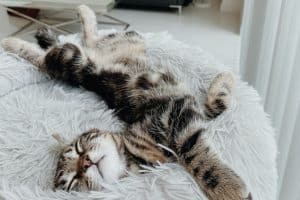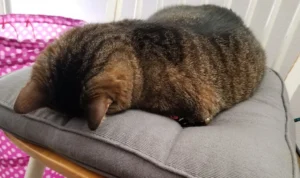Cats have an uncanny ability to mimic human behaviors, including the way they sleep. Have you ever noticed your cat curling up in a cozy ball or stretching out like a person in slumber? It’s a common sight that sparks curiosity about why cats sleep like humans.
In the following outline, we will explore the intriguing reasons behind cats’ sleeping habits and delve into the similarities between feline and human sleep behaviors.
Cats Are Crepuscular Creatures
Cats are crepuscular animals, meaning they are most active during dawn and dusk. This natural behavior is inherited from their wild ancestors who were most active during these times to hunt for prey. As a result, cats have adapted unique sleeping patterns that align with their crepuscular nature. They tend to sleep for longer periods during the day and night to conserve energy for their peak activity times.
In addition to their crepuscular behavior, cats are known for their flexible sleeping habits. They often cat nap throughout the day, taking short rests to recharge. This pattern resembles the multiple short sleep cycles that humans experience during the night, making their sleeping habits seem more relatable to us.
Seeking Comfort and Security
When it comes to finding the perfect spot for a snooze, cats are no different from humans. They seek out cozy, warm places that provide a sense of comfort and security. Whether it’s a sunny spot by the window, a soft blanket on the couch, or a snug hiding spot in a closet, cats instinctively gravitate towards areas that make them feel safe and relaxed.
Moreover, cats are experts in creating a sense of security around them while they sleep. They often curl up into a ball, tuck their heads under their paws, and even purr softly to lull themselves into a deep slumber. This behavior mirrors the way humans subconsciously seek out comfort and security when we tuck ourselves into bed at night.
Additional Unique Insight:
One interesting behavior that cats exhibit when seeking comfort and security during sleep is their tendency to knead on soft surfaces. This behavior, known as “making biscuits,” stems from kittenhood when they knead their mother’s belly to stimulate milk flow. As adults, cats continue this behavior as a way to comfort themselves and create a sense of security.
Remember, understanding why cats sleep like humans can help deepen the bond between you and your feline companion. By providing them with comfortable sleeping spots and a sense of security, you can ensure that your cat gets the rest they need to stay happy and healthy.
Mimicking their Human Companions
Cats have been known to mimic the behaviors of their human companions, and this includes their sleeping positions. By mirroring how humans sleep, cats may be expressing a form of bonding and closeness with their owners. So, if you find your feline friend snoozing in a similar way to you, it could be their way of showing affection and connection.
Dreaming Like Humans?
Have you ever wondered if cats dream like humans do? While more research is needed, some experts believe that cats go through similar sleep cycles as humans, including REM sleep where dreaming occurs. If you notice your cat twitching or making noises while asleep, they could be experiencing their own dream world just like we do.
Unique Insight: Cats’ Flexible Bodies
Cats have incredibly flexible bodies that allow them to contort themselves into various sleeping positions, much like humans. From curling up in a ball to stretching out on their side, felines can adapt their sleeping postures to find the most comfortable position for a restful slumber. This flexibility may also contribute to why cats sometimes sleep in ways that resemble how humans do.
The Importance of Sleep for Cats
Quality sleep is essential for our feline friends just like it is for us humans. Cats require adequate rest to maintain their health and general well-being. A good night’s sleep can directly impact a cat’s behavior and mood during the day. Just like humans, cats need sufficient sleep to help them recharge and stay alert. Lack of quality sleep can lead to irritability, decreased energy levels, and even potential health issues in cats.
Sleeping Positions: What They Reveal
Cats have unique sleeping positions that can tell us a lot about how they’re feeling. Here are some common sleep positions and what they might indicate: 1. Curled up: This position often means a cat is feeling relaxed and secure. 2. On their back: Cats who sleep on their back may be showing trust in their surroundings. 3. Tucked in: A cat who tucks themselves in tightly might be feeling cold or seeking comfort. 4. Belly up: While it may look cute, a cat exposing their belly can be a sign of vulnerability.
Bonus tip: Pay attention to any changes in your cat’s sleep positions, as they could indicate underlying health issues or discomfort that need to be addressed. Keeping an eye on their sleeping habits can help you monitor their overall well-being.
For more information on feline sleep habits, you can visit the American Association of Feline Practitioners website: American Association of Feline Practitioners.
Cat Napping vs. Deep Sleep
Cats are not just lazy creatures; they have specific sleep patterns that closely resemble human sleep stages. While cats are known for their quick cat naps throughout the day, they also delve into deep sleep stages similar to humans. These deep sleep stages are crucial for their overall health and well-being.
During cat naps, cats typically rest with their eyes closed but are still somewhat aware of their surroundings. This light sleep allows them to quickly react if needed. On the other hand, deep sleep in cats is characterized by a complete relaxation of their bodies, with REM (Rapid Eye Movement) sleep occurring. This is when you might notice your furry friend twitching or moving their whiskers and paws.
Interestingly, studies have shown that cats can experience similar sleep stages as humans, including light sleep, deep sleep, and REM sleep. This similarity in sleep patterns may explain why cats often sleep in positions or environments that mimic human sleeping habits. So the next time you catch your feline companion snoozing in a cozy spot, remember they might be experiencing sleep stages similar to your own.
Beyond Sleeping: Feline Habits and Behaviors
Besides sleeping like humans, cats exhibit various habits and behaviors that shed light on why they may prefer certain sleeping positions or environments. One key behavior is their meticulous grooming ritual. Cats are known for spending a considerable amount of time grooming themselves, which is not just about cleanliness but also a way to mark their territory and maintain social bonds with other felines.
In addition to grooming, cats are territorial animals, and their sleeping habits may be influenced by their need to feel safe and secure in their environment. Cats often choose sleeping spots that offer them a vantage point, allowing them to keep an eye on their surroundings and potential threats. This behavior stems from their wild ancestors who needed to stay vigilant to survive in the wild.
Furthermore, cats are crepuscular animals, meaning they are most active during dusk and dawn. This natural inclination might explain why they have adapted to sleeping patterns that align with human sleep schedules. By understanding these feline behaviors, you can create a comfortable and secure sleeping environment for your cat that mimics their natural instincts.
- Providing multiple cozy sleeping spots throughout your home can cater to your cat’s need for security and territory.
- Interactive playtime and mental stimulation during the day can help your cat engage in natural behaviors and promote better sleep at night.
- Creating a structured routine for feeding and play can also help regulate your cat’s sleep patterns, ensuring they get the rest they need.
Alex, a passionate animal lover, has experience in training and understanding animal behavior. As a proud pet parent to two dogs and three cats, he founded AnimalReport.net to share insights from animal experts and expand his knowledge of the animal kingdom.




